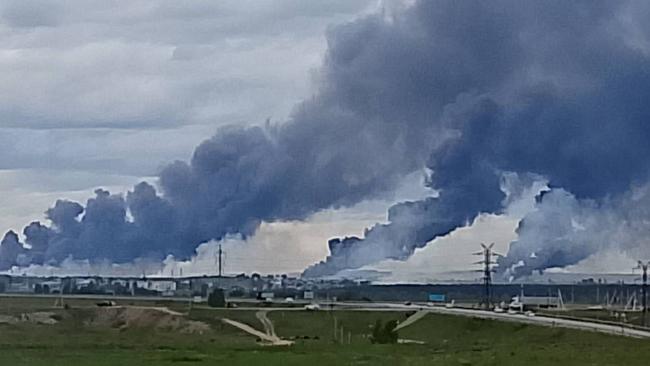Ukraine offers Australia aid in asymmetric warfare
Ukraine’s stunning military strike on Russia, in which it wiped out 30 per cent of the country’s bomber fleet, shows it has valuable military technology to share with Australia, Kyiv’s envoy says.

Ukraine’s stunning weekend military strike on Russia, in which it wiped out 30 per cent of the country’s strategic bomber fleet with 117 secretly deployed drones, showed it had valuable military technology and experience to share with Australia in return for its ongoing assistance, the country’s Canberra-based envoy says.
Vasyl Myroshnychenko told The Australian Kyiv was ready to pay Australia back for its continuing assistance in its David and Goliath battle with Russia by helping it establish an indigenous autonomous weapons production sector and sharing its vast experience in asymmetric warfare.
He also urged Prime Minister Anthony Albanese to return to Ukraine in the European summer, three years after he first travelled to Kyiv to see the impact of the Russian war on the European nation for himself.
“I understand the Prime Minister will be going to Europe after visiting Canada and the US, so after that would be a good time to go to Ukraine,” the envoy said.
“When I saw him in January he said: ‘Vasyl, I’m going to win this election and then I’m going to go to Ukraine.’ I believe a good time is now because this is what Ukrainian people need – support from so far away.”
Ukraine has been pushing Australia to provide more Bushmaster armoured vehicles and spare parts, several hundred Vietnam War-era M113 armoured personnel carriers, Australian-manufactured Hawkei partially armoured vehicles, as well as more ammunition and explosives.
The federal government has already provided Kyiv with 120 Bushmasters since the 2022 Russian invasion, along with 49 Abram tanks, ammunition, defence technology components and has also provided $1.5bn in assistance.
Mr Myroshnychenko said while the Ukrainian forces still relied on traditional military equipment, it could do more for Australia than Canberra may have imagined three years ago, “when it was all about defending democracy and the rules-based system”.
“We keep asking Australia for support, but we can now do more for Australia in terms of new technology, new sovereign defence capabilities and asymmetric warfare,” Mr Myroshnychenko said on the sidelines of the Justice Denied conference on conflict and gender-related violence in Melbourne.
“For the past three years, Ukraine has relied on the support of western countries, including Australia, to send tanks, artillery and ammunition, for which we will be forever grateful, but the way our military has developed I think the ADF has much to learn from Ukraine on asymmetric warfare and defence technology. It’s state of the art driven by necessity.
“We get equipment and technology from partners, we test what works on the battlefield and improve what works.
“Operational autonomous systems are something we have learned how to do, and we have demonstrated how effective they can be.”
Ukraine produced one million drones last year and was on target to produce four million air, underwater and on-ground drones this year.
It has developed drones connected by fibre optic cable to military bases that don’t rely on GPS systems that can be deployed up to 20km to penetrate enemy targets, and recently infiltrated Russia’s Black Sea port of Novorossiysk with an underwater drone that shot down a Russian fighter jet from underwater.

Mr Myroshnychenko said the level of innovation achieved by Ukrainian military forces on the battlefield was “staggering”.
But its most recent weekend success, in which four key airfields deep inside Russian territory were targeted by more than 100 cheaply produced and remotely activated drones fired from the concealed roofs of container trucks, could be the turning point in the conflict that forces Russia to the negotiating table.
Ukraine’s ability to destroy billions of dollars’ worth of high-value assets with relatively inexpensive weaponised drones is expected to recalibrate defence priorities around the globe as countries move to protect now vulnerable military weapons.
“This is not yet a knockout, but quite a serious knockdown for the enemy,” said Iryna Vereshchuk, a top official in President Volodymyr Zelensky’s office. “This is exactly what wars of the future will look like.”
The top-secret 18-month operation, code-named Operation SpiderWeb, was personally overseen by Mr Zelensky and came hours before a new round of peace talks were set to start in Istanbul.
The drones hit the Olenya air base in Murmansk, home to nuclear-capable bombers, the Belaya air base in the Siberian area of Irkutsk, the Ivanovo air base in Ivanovo, and the Dyagilevo air base in Ryazan.
Prized bombers which Russia no longer has the capacity to produce, such as the Tu-22M3, the Tu-95 and the A-50, were destroyed within minutes of each other.
Videos posted to social media showed drones appearing to take off out of one container, an explosion striking a plane parked at an airport, while footage shared by Russian media showed men climbing onto a truck to try to stop the drones.
The operation, which relied on the same element of surprise deployed by Israel when it remotely activated 5000 pagers fitted with explosives to demoralise Hezbollah last September, employed artificial intelligence to ensure the drones hit the bombers’ fuel tanks, their weakest point.
Mr Myroshnychenko said Australia had “skin in the game” of the Russian war on Ukraine, given the outcome of this war was “going to define security architecture globally and also in Asia-Pacific”.
“We have seen how global supply chains can be easily disrupted. Imagine how a war in the South China Sea would disrupt Australia’s ability to be resupplied with ammunition,” he told The Australian.
“Australia needs its own manufacturing capacity of various weapons and military equipment, to have sovereign defence capability. Drones have become a very cheap and efficient way to build up deterrence because you can carry drones 4000km away and deploy them.
“We can teach Australia how to do it and help them set up the production you need that works.”




To join the conversation, please log in. Don't have an account? Register
Join the conversation, you are commenting as Logout